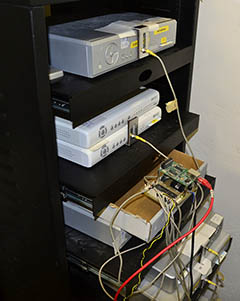
Web Remote Control Evolution
After 9 years of day and night continuous work (mostly on night) with the journalists changing via web the channels of the centralized decoders to see the sport events, it’s time to update the WRC.
I changed the old PIC18F452 with a pin-to-pin compatible but more powerful PIC18F4620. Ported the firmware from Microchip MPLAB to the new, multi-platform, MPLABX and modified it in order to use the AnalysIR output as a C array for timing the IR carrier pulses.
This is the development environment used. AnalysIR (on a virtual machine) to capture the RC codes needed and export them. An MPLABX session to convert the codes into C arrays to use as pulse timing. The web interface used to change the channels. Underneath AnalysIR there is a terminal session that started node.js server and open the serial interfaces.